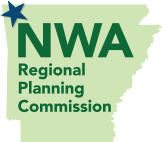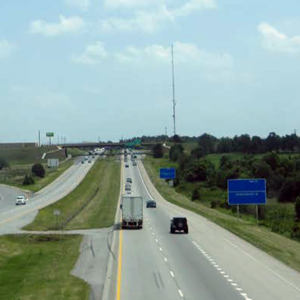Transportation
Intelligent Transportation System Architecture (ITS) Plan
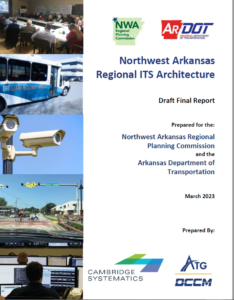 Development of a regional Intelligent Transportation System (ITS) architecture is one of the most important steps in planning for and implementing ITS in a region.
Development of a regional Intelligent Transportation System (ITS) architecture is one of the most important steps in planning for and implementing ITS in a region.
ITS architectures provide a framework for implementing ITS projects, encouraging interoperability and resource sharing among agencies, identifying applicable standards to apply to projects, and allowing for cohesive long-range planning among regional stakeholders.
NORTHWEST ARKANSAS ITS PRIORITIES AND ACTION ITEMS
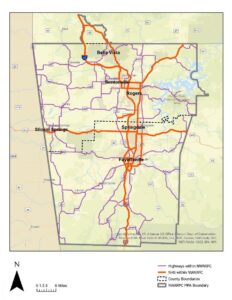 To guide the development of the Regional ITS Architecture, the study team developed statements regarding vision, mission, goals, and objectives for the ITS program. These statements were used to identify the high- priority strategies and action items that will be advanced to address mobility and other needs in Northwest Arkansas and meet the strategic goals and objectives for ITS defined in the ITS Architecture Strategic Planning Workshop. These high-priority strategies are listed below with a summary of suggested action items to form the basis for the update of the Regional ITS Architecture and Deployment Plan.
To guide the development of the Regional ITS Architecture, the study team developed statements regarding vision, mission, goals, and objectives for the ITS program. These statements were used to identify the high- priority strategies and action items that will be advanced to address mobility and other needs in Northwest Arkansas and meet the strategic goals and objectives for ITS defined in the ITS Architecture Strategic Planning Workshop. These high-priority strategies are listed below with a summary of suggested action items to form the basis for the update of the Regional ITS Architecture and Deployment Plan.
Strategy 1: Improve the efficiency, effectiveness, and safety of regional traffic management.
Action Items
1. Identify the equipment and software used by each jurisdiction within the region to determine compatibility and interoperability.
2. Identify the additional traffic management functions desired collectively in the region and for each jurisdiction.
3. Initiate a regional strategy to develop a fiber optic communication and signal systems connectivity plan.
4. Initiate a regional discussion of the desirability of achieving signal controller consistency in the region over time as a means of supporting coordinated timing between the cities.
Strategy 2: Collect, store, and share more travel-related information to improve operations and traveler information for users of all modes.
Action Items
1. Identify the additional data desired for traffic management functions collectively in the region and for each jurisdiction, and identify priorities for collecting, storing, and sharing the data.
2. Initiate a regional program for logging, displaying, and tracking planned lane or road closures for maintenance, construction, or special events.
Strategy 3: Improve the regional emergency response to traffic incidents, major storms, and other emergency situations.
Action Items
1. Formulate a regional strategy among the agencies involved for improving emergency response.
2. Identify the data, communications, and protocols necessary to improve regional emergency response and the ITS elements necessary to support it.
Strategy 4: Use ITS to improve access to and safe use of alternative modes of transportation, and to reduce motor vehicle emission and vehicle miles of travel.
Action Items
1. Organize a regional committee to identify opportunities to improve the access to and safe use of alternative modes of transportation, and to promote demand-management strategies.
2. Identify ITS elements that can be employed to improve the access to and safe use of alternative modes of transportation, and prioritize the potential ITS applications.
3. Identify and pursue potential funding sources for ITS elements that can be employed to improve the access to and safe use of alternative modes of transportation.
Strategy 5: Increase regional collaboration on ITS development and applications.
Action Items
1. Continue to use NWARPC and its committees to promote coordination between the various stakeholders in Northwest Arkansas, including, but not limited to, ARDOT, NWARPC, cities, counties, transit authorities, and private sector companies.
2. Include ITS in planning, programming, design, construction, and maintenance processes.
3. Develop a communication framework for the region’s
stakeholders to facilitate input on ITS strategies.
4. Integrate ITS champions into the regional and local decision-making bodies.
5. Encourage data and information sharing between the
region’s stakeholders.
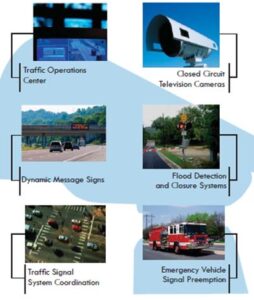 ITS is the application of electronic technologies and communications to increase the safety and efficiency of the transportation system. The ITS architecture allows stakeholders to plan for what they want their system to look like in the long-term and then break the system into smaller pieces that can be implemented over time as funding permits.
ITS is the application of electronic technologies and communications to increase the safety and efficiency of the transportation system. The ITS architecture allows stakeholders to plan for what they want their system to look like in the long-term and then break the system into smaller pieces that can be implemented over time as funding permits.
In order to be eligible for funding of ITS projects from the Federal Highway Administration (FHWA) or the Federal Transit Administration (FTA), regions must show that their projects conform to their regional ITS architecture. This requirement became effective in April 2005 as part of 23 CFR Part 940.
The Northwest Arkansas Region is defined by the boundaries of the Northwest Arkansas Regional Planning Commission (NWARPC), as shown by the dark line in the map. The region encompasses 1,836 square miles in northwest Arkansas. It is contained within Benton and Washington Counties, and the major cities in the area include Fayetteville, Springdale, Rogers, and Bentonville. The rapidly growing area had a population of roughly 530,000 in 2020 and is expected to reach one million residents by 2045, reflecting an annual average growth rate of 2.5%. The current employment in the region is roughly 250,000 and has grown at a rate of 3.5% over the past five years.
